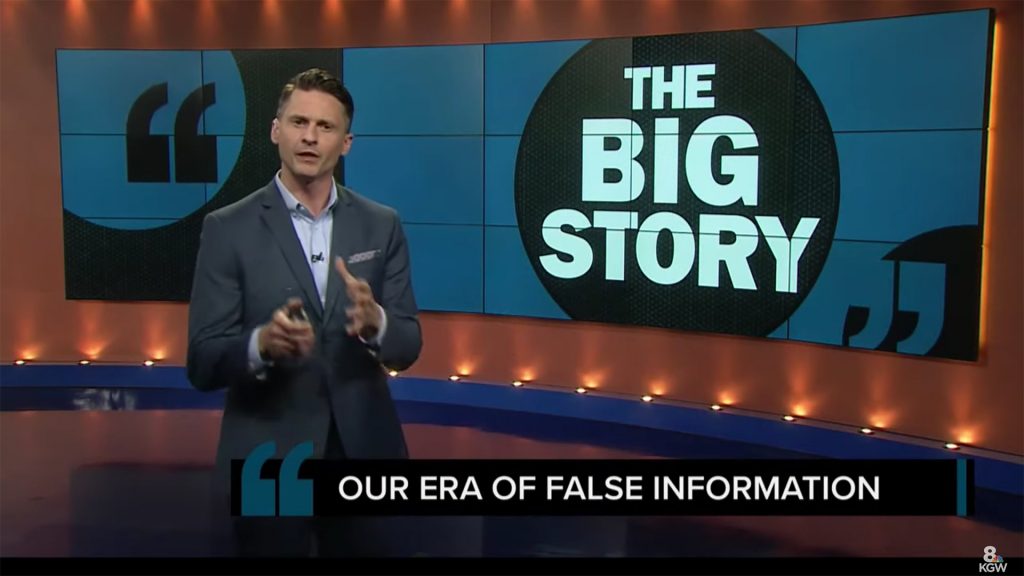
“I’m surprised it’s gone as well as it has,” says KGW anchor Dan Haggerty.
One year ago this week, Haggerty was part of a small team that took a big risk. Tegna’s Portland, Oregon station transformed its legacy 6 p.m. newscast into a daring experiment called The Story With Dan Haggerty. The broadcast is a unique mix of in-depth reporting, investigations, interviews, audience feedback, humor, and opinion — all delivered in Haggerty’s signature style.
If covering the extraordinary events of 2020 was a challenge for every local newsroom in America, it was a baptism of fire for this innovative program that set out to break the rules of TV news and quickly had to make up some new ones of its own. “This show could not have come at a better time for the year that Portland had,” says producer Brian Kosciesza. “That was something we would try to do every day: ‘How can we meet the moment today?’”
And Portland had “moments” in abundance: the coronavirus pandemic, raging wildfires that attacked the city itself last summer, and protests and riots following the killing of George Floyd that continue several nights a week in the city even now. “That was the point of the show all along, that deeper discussion of issues,” says KGW news director Greg Retsinas. “We thought the issues would be the environment, homelessness, economics, affordability, housing, politics, the full gamut of issues that we have on our roster. And all that got scrapped by events in the world.”
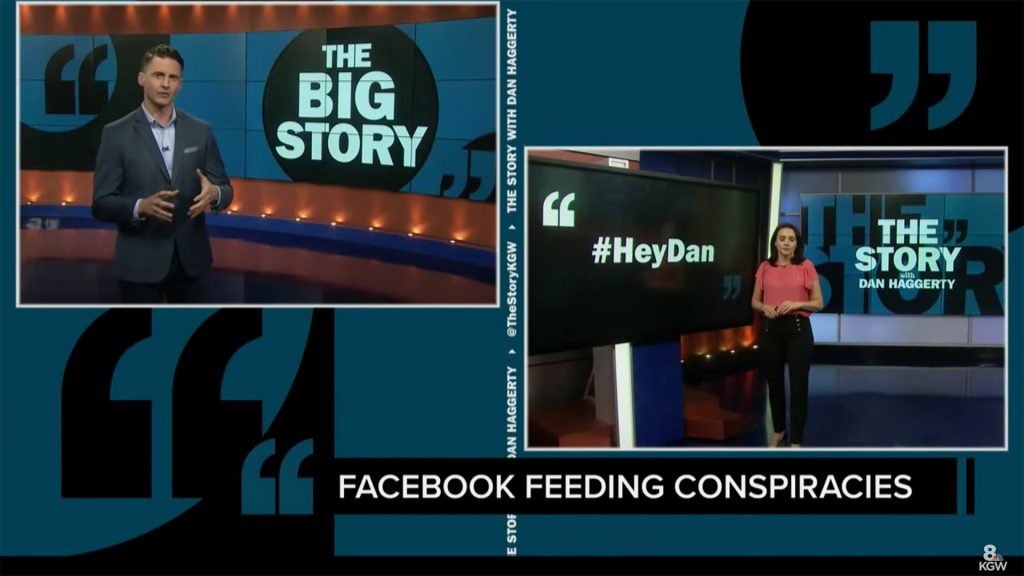
“I thought that we did a good job of building context around extremely delicate and complex conversations and issues that the country was having,” Haggerty says. “And I think that our show came around at the right time, because I know from the people who emailed every single night that they found value in it that they weren’t finding other places.”
I reached out to the KGW team to share lessons learned in the year since we first reported on the show — and to see what aspects of The Story’s story might be relevant to other newsrooms seeking to break the mold.
The Story relies heavily on audience input, harvested from social media, for story ideas and feedback. And the program itself is infused with the viewers’ comments and questions, giving them a real voice in each night’s episode. “The viewers are part of the content and part of the journey, and they’re part of the makeup of the show,” Retsinas says. “We wouldn’t do the show without them. And we couldn’t do the show without them.”
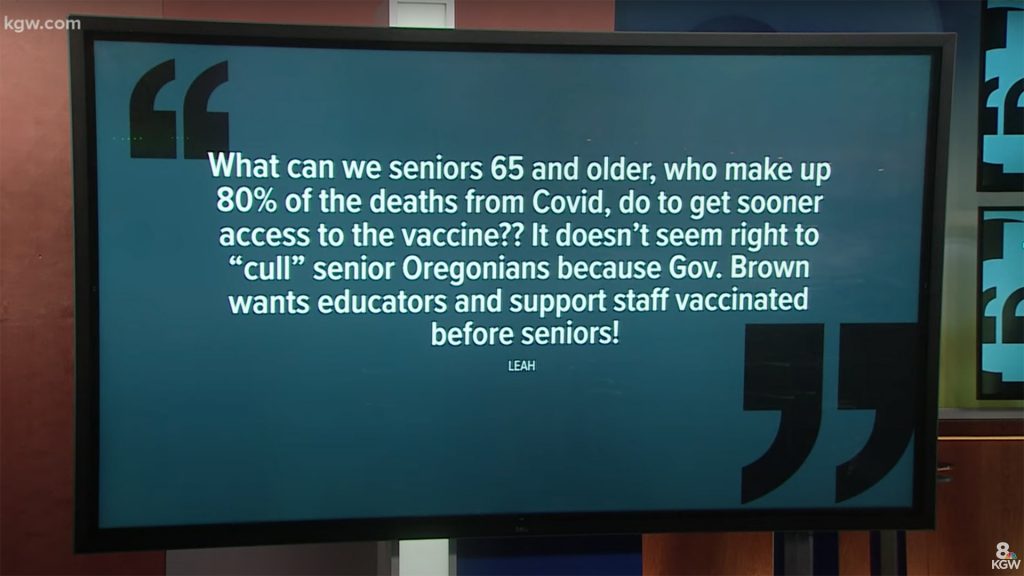
“I remember having a lot of anxiety about having a social element be such a major part of the show, because there’s always that fear that people aren’t going to respond and that you’re going to be opening emails to the noises of crickets every night,” Haggerty says. “And that has not been the case. And it wasn’t the case, starting the first week of the show.”
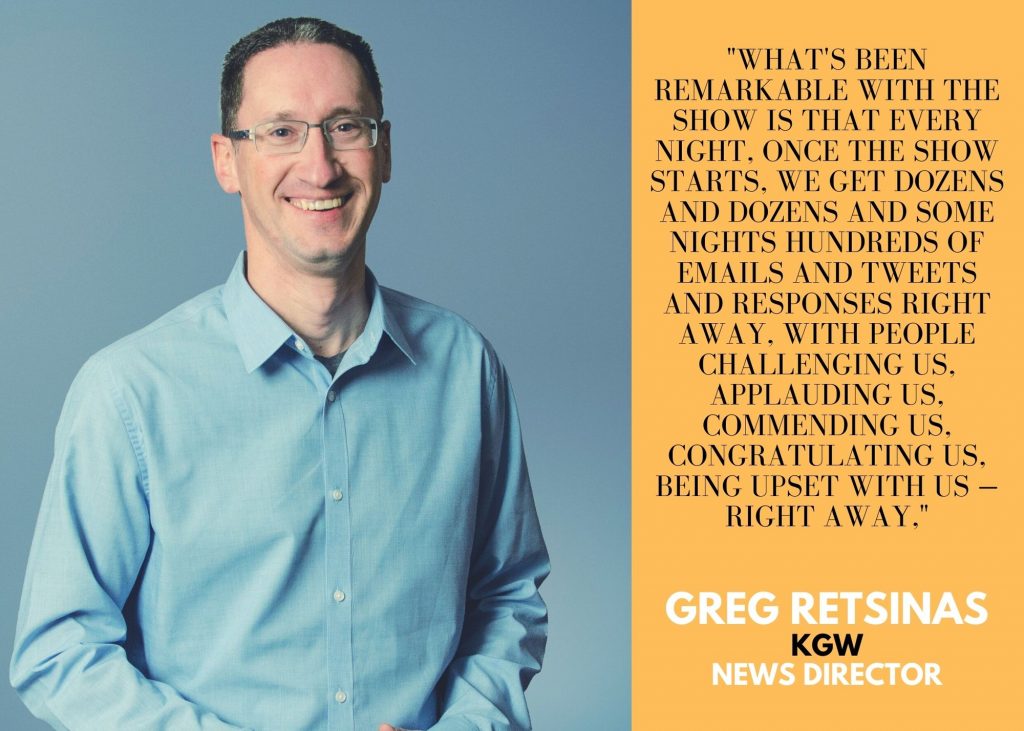
Haggerty, who might spend five minutes on air answering a viewer’s question, gives the audience credit for many of the team’s day-to-day decisions. “It helped us steer the ship,” he says. “We very rarely went into a day thinking, ‘Where do we go with this today?’ Because we just listened to our audience and to our own judgment on things, and it’s kept us on course.”
Mila Mimica became The Story’s executive producer in August, drawn in part by the viewers’ role in shaping the content. “For me, it was a really good opportunity, as somebody who was starting to get slightly jaded by the daily kind of regular newscasts, to jump in and see what it is that people actually want to watch, what they want to talk about, what resonates in our community,” Mimica says.
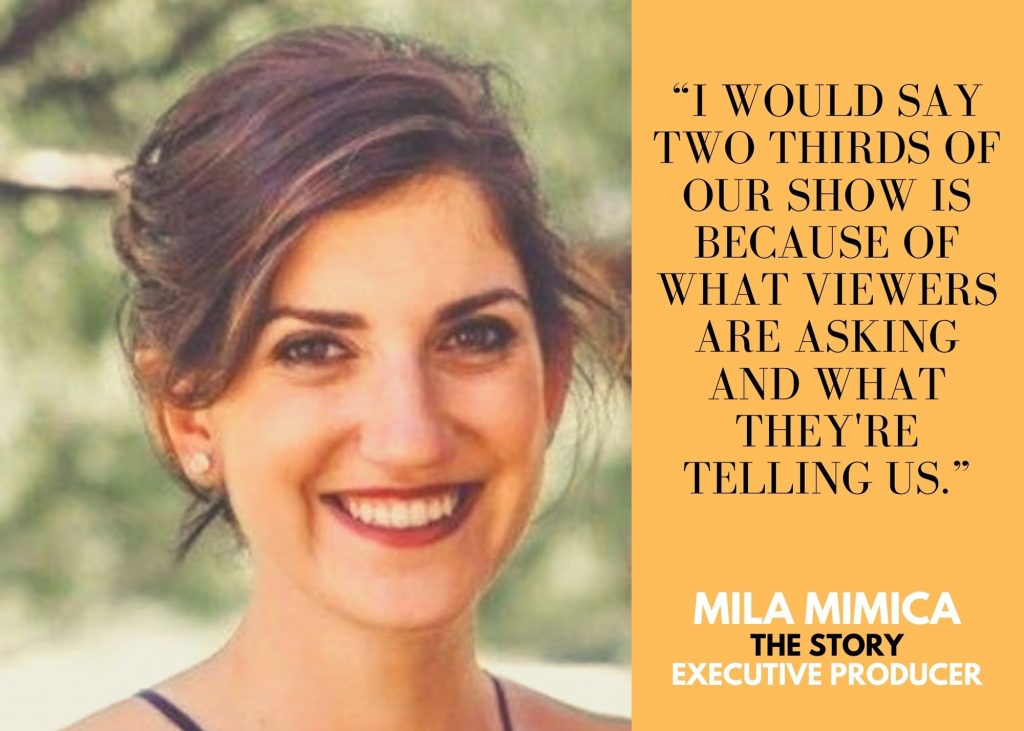
Unlike conventional TV news anchors, The Story doesn’t shy away from stating a position on issues — wearing a mask to protect against the coronavirus, say. “Some people may decide this is not the show for them, because we’re not going to be, ‘On the one hand, on the other hand,’” Retsinas says. “We’re going to have a point. And our point was measures like that work. We’re not going to be the solution to divisions in America. But hopefully we can be part of the conversation about solving it. We can better amplify and highlight facts and truth and fight the disinformation, misinformation that seems to cause a lot of the divisions.”
WATCH an episode of The Story on misinformation and disinformation
Haggerty’s on-air opinions come with another caveat: not just a foundation in facts, but a respect for the audience. “We discovered that we could have an opinion without telling people that they had to have that same opinion,” Kosciesza says. “I think it gives [the viewers] comfort that even if they don’t agree with something, or the way that we do something, they can verbalize that to us, and we’ll listen,” Haggerty says. “And I think people do want to be heard, they want to have that respect given to their opinions. And we give that.”
Again, the goal is to spark an ongoing dialogue with the viewers: in Retsinas’s words, “not in a sound bite way, not in a blame way, not in a ‘I’m smart, you’re dumb’ kind of way. Let’s have a discussion about it. And let’s lean on facts to help inform a better conversation.”
Humor and irreverence are a key ingredient. “No matter what, we tell the facts, we’re ‘big J’ journalism,’” Mimica says. “We fact check, we do everything right. And then on top of that, you get another layer where you have a little bit of fun, you loosen up a little bit.”
Example: In November, viewers clamored for The Story to mark the 50th anniversary of a famous local incident in which state engineers used dynamite to blow up the carcass of a 45-foot sperm whale that had washed ashore in Florence, Oregon. Trouble is, unlike a crosstown competitor, KGW didn’t have video of the 1970 incident, so the team came up with a new segment called “No Video, No Problem.” Haggerty retold the story by drawing on an erasable white board.
WATCH The Story’s “No Video, No Problem” segment on the exploding sperm whale
“We try to have one moment in our show where we get a little offbeat, because we found that those irreverent, offbeat moments were the ones that people remember,” Kosciesza says. “The ones they kept emailing about and kept saying, ‘Oh, my God, I love when you did that.’ Nobody writes about city hall meetings.”
But like his opinions, Haggerty’s irreverence only works in the context of solid journalism. “When you are being funny, or if you’re trying to do something sarcastic or weird, if you don’t have the fundamentals, then it’s only going to be those things,” he says. “It’s not going to be smart, it’s not going to have a point.”
Producing The Story is a balancing act: on the one hand, no formulas. On the other, strict adherence to the program’s vision and personality. “One of the missions of The Story is that this is our own newscast in our own way,” Retsinas says. “There are no must-cover, must-carry, must-watch, must-do rules: The word ‘must’ is not part of The Story’s mission. Be a different kind of show.”

Mimica, Haggerty, and the three-person producing team keep a close eye on what the rest of the newsroom is doing, looking for opportunities to build on existing coverage and tap into individual reporters’ expertise, but in the program’s unique way. “We developed as a team the ability to spot Story stories,” Kosciesza says. “Is this a Story story? Or is this not? We know what we don’t want to cover. And now we have to decide what we do want to cover.”
The Story may look spontaneous and free-wheeling, but it’s also just the opposite. “Dan needed to be freed from the shackles of the traditional newscast to do it in this modern way that The Story tried to,” Kosciesza says. “So we just kind of let Dan be Dan.” But Haggerty is quick to point out, with admirable candor, that he and the producers carefully map out pretty much everything he says. “I have a huge amount of trust in the team that I work with. And I don’t ever just go on TV and do my own thing. We discuss everything. Sometimes I want people to see the prompter when it seems as though I’m going off the cuff. This is something we have planned. We are very intentional on the show, even in our attempts to try to look like we’re not.”

What would it take for other stations to emulate The Story — assuming any of them wants to take the risk? For starters: supportive leadership, a strong vision, talented producers and editors, and a versatile anchor like Dan Haggerty. “The stars [have to] align to create this, but it’s really, really hard,” says Kosciesza. “It’s the hardest show I’ve ever had to produce just in terms of creativity.” “It’s really hard,” agrees Haggerty, “because there is a formula to television news, and there is a certain comfort in that formula. And we’ve tried to throw all of that out the window and just start from scratch. And while that in itself is very difficult, it’s also terrifying.”
Brian Kosciesza just left KGW for a segment producer job at MSNBC. His colleague Stephanie Villiers is holding the fort, along with the original team’s digital maven Christina Kempster, but Mimica is looking for a new lead producer. If you think you’re the right person for the job, you can email her at mmimica@kgw.com. (You’re welcome.)
KGW still posts the complete shows on YouTube every night. “Many people might engage with us socially and never watch the show. That’s totally okay,” Retsinas says. “We’re not trying to drive everyone to stop their world at 6 p.m. and sit down. Enough will.”
To that point, Retsinas says The Story is “definitely a success.” Without agreeing to get specific about the numbers, Retsinas says, “We’re very pleased with the growth of this show and the strength and the quality of our audience across all platforms. Very pleased.”
Retsinas says he doesn’t hear as much these days from critics of the show, probably because some of them have given up and moved on. “Now the feedback we get from people is largely ‘Thanks for having a show like this on local news. Thanks for having this kind of show.’ No doubt about it.”
I asked Dan Haggerty to complete the following sentence: “The Story will have succeeded if we …”
Haggerty: “… get people to care about the local news as much as they should.”
Get the Lab Report: The most important stories delivered to your inbox